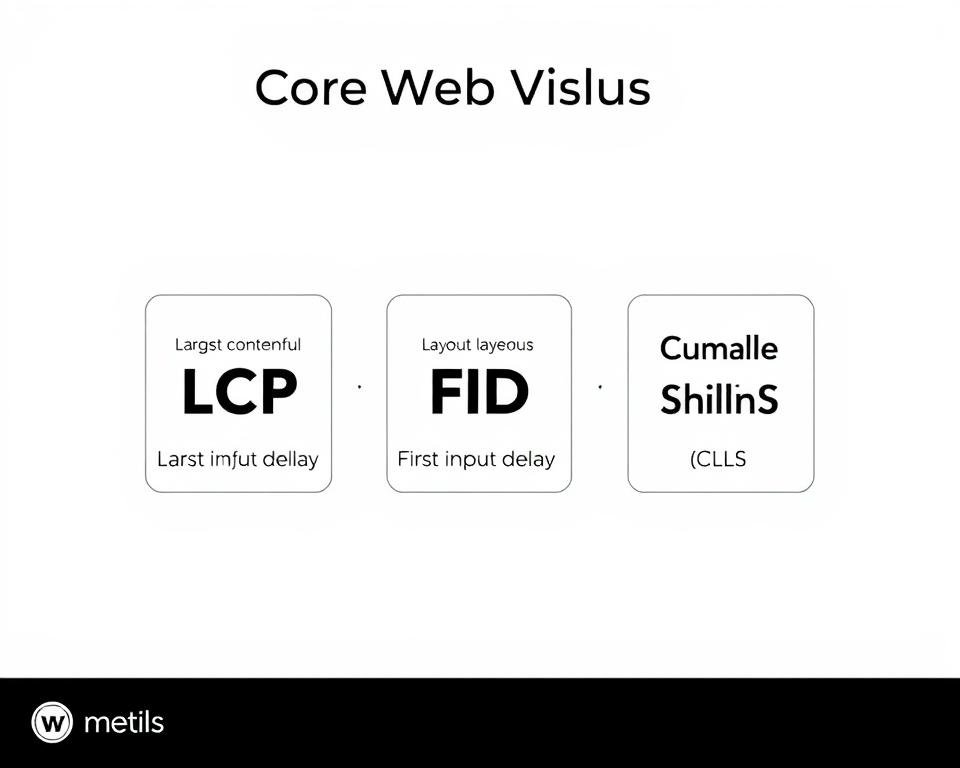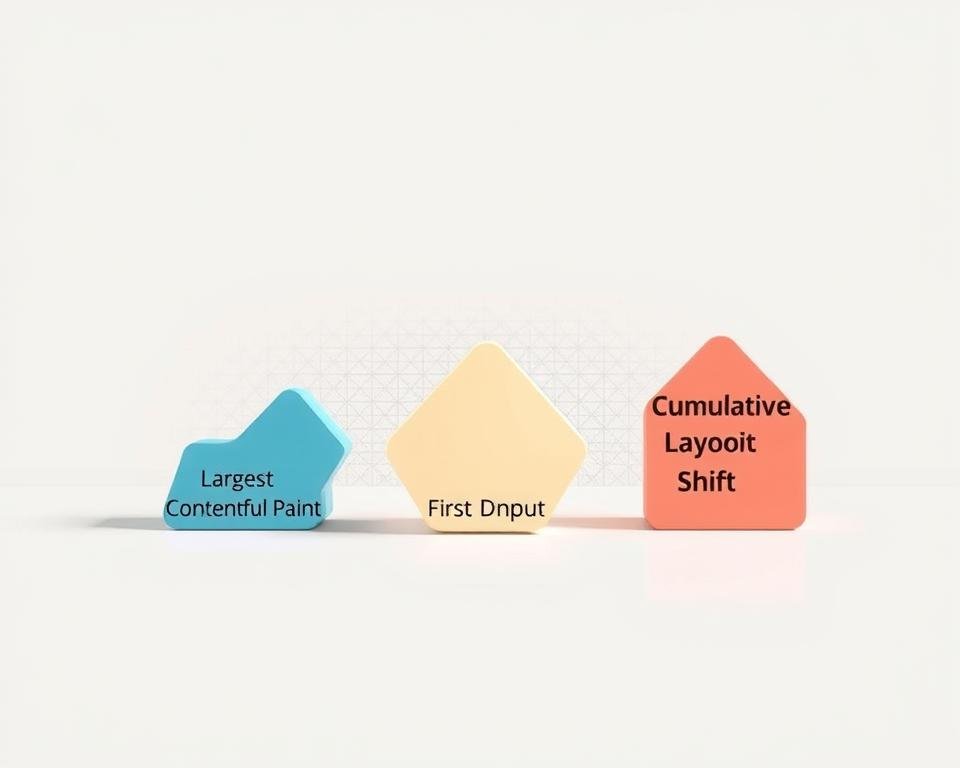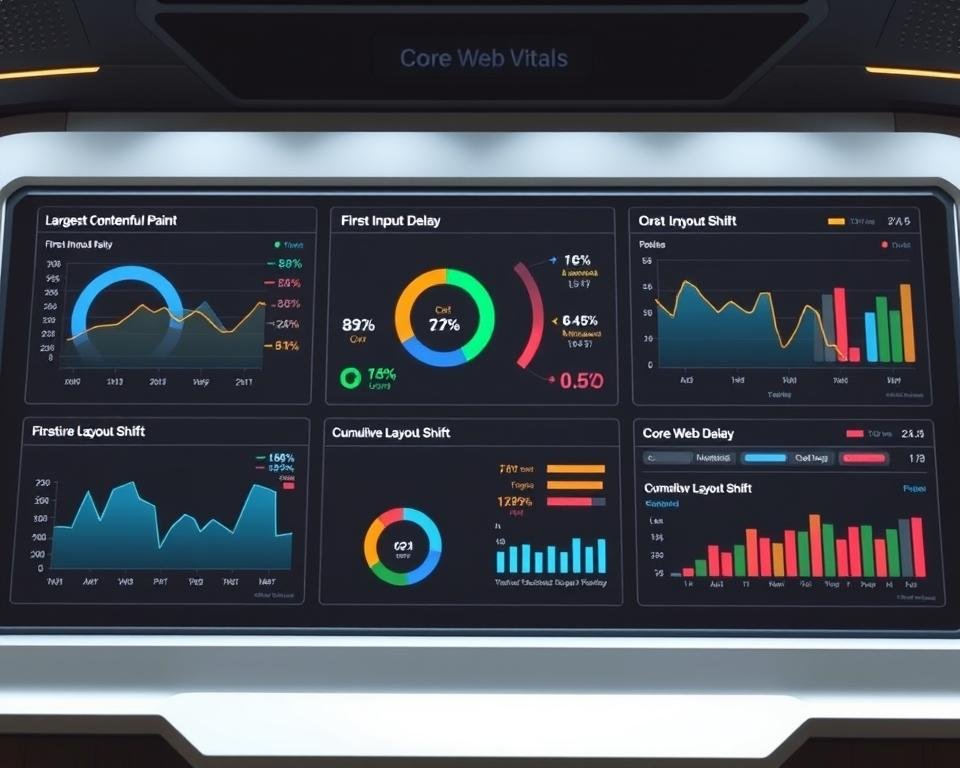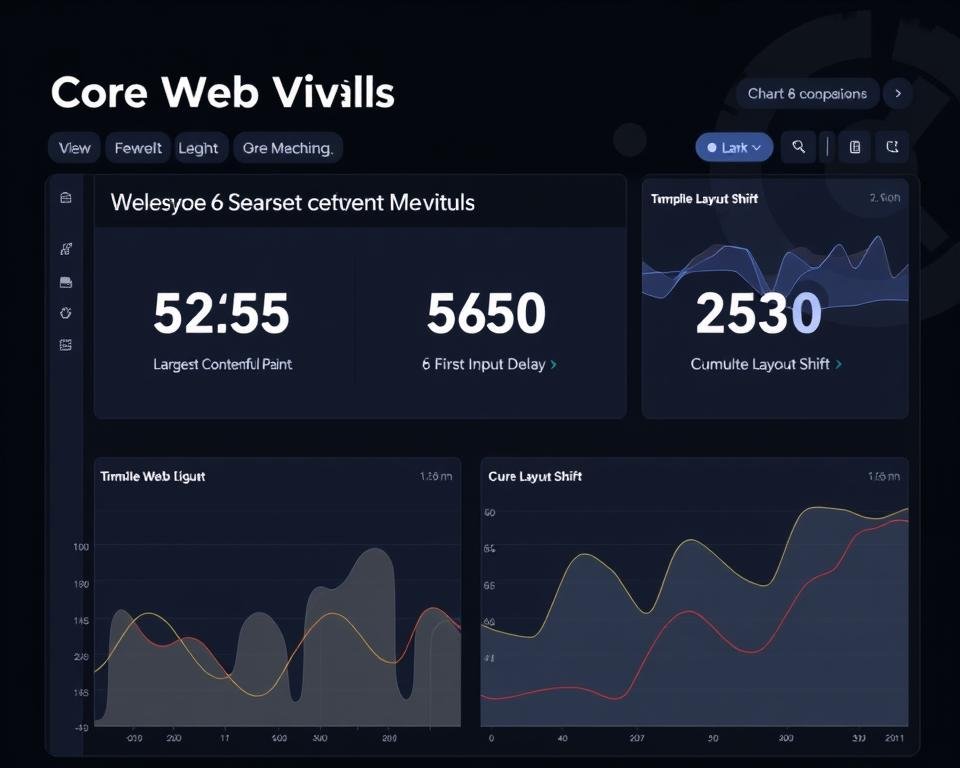As a website owner, knowing Core Web Vitals is key to better Google rankings. I’ll explain what you need to know about these metrics and how they help your website succeed.
Core Web Vitals are important metrics Google uses to check a website’s user experience. They look at how fast the site loads, how interactive it is, and how stable it looks.
These metrics are very important for your website’s success. They directly affect your Google rankings. By understanding and improving Core Web Vitals, you can make your website better for users and search engines.
Key Takeaways
- Core Web Vitals measure user experience, including loading speed and visual stability.
- These metrics directly impact Google rankings.
- Optimizing Core Web Vitals improves website user experience and search engine ranking.
- Understanding Core Web Vitals is very important for website owners.
- Core Web Vitals are a key factor in determining website success.
Understanding Core Web Vitals
Core Web Vitals is key in web development. It affects how users feel about a site and its ranking in search engines. Knowing its importance helps improve a website’s performance.
Introduction to Core Web Vitals
Core Web Vitals measure a website’s user experience. They look at loading speed, how interactive it is, and its visual stability. Web developers use these metrics to make websites better.
Core Web Vitals Metrics include Largest Contentful Paint (LCP), First Input Delay (FID), and Cumulative Layout Shift (CLS). These metrics are important for a good user experience.
Key Metrics Explained
Here are the three main Core Web Vitals Metrics:
- Largest Contentful Paint (LCP): Measures when the biggest content element appears in the viewport.
- First Input Delay (FID): Checks how fast a website responds to the first user action.
- Cumulative Layout Shift (CLS): Looks at how stable a website’s layout is, avoiding sudden shifts.
| Metric | Description | Importance |
|---|---|---|
| LCP | Loading Speed | High |
| FID | Interactivity | High |
| CLS | Visual Stability | High |
Importance in User Experience
The Importance of Core Web Vitals is huge. They affect how users feel about a website. A site with good scores keeps users engaged, lowers bounce rates, and boosts conversions.
By improving these metrics, developers make websites more appealing and easy to use.
How Core Web Vitals Impact SEO
Core Web Vitals are now key in Google’s ranking factors. They are a big part of SEO strategies. Understanding their impact on SEO is important.
Google wants to give users the best results. It looks at how well a website works for users. Core Web Vitals play a big role here.
Google’s Ranking Factors
Google’s algorithm ranks websites in a complex way. Core Web Vitals are part of this. The main factors are:
- Page loading speed: A fast page is good for users.
- Interactivity: Websites should work well with user actions.
- Visual stability: A stable layout is key to avoid user frustration.
Google wants users to have a good time on websites. This helps with rankings.
Connection to Page Experience
Core Web Vitals measure user experience on websites. Improving these metrics can make websites better. This can lead to higher rankings.
To use this to your advantage, you should:
- Keep an eye on Core Web Vitals to find what needs work.
- Work on making your website faster and better for users.
- Make sure your website works well on mobile devices, as this is important now.
This way, you can boost your rankings and give users a better experience.
The Three Main Metrics of Core Web Vitals
The three main metrics of Core Web Vitals are key to checking your website’s performance. They show how users interact with your site. This helps you find ways to make your site better and rank higher in search engines.
Largest Contentful Paint (LCP)
Largest Contentful Paint (LCP) shows how fast the biggest part of your page loads. It’s important because it affects how quickly users see your page’s main content. To improve LCP, make images smaller, use browser caching, and cut down on CSS and JavaScript files.
For example, shrinking images can really help with LCP. TinyPNG or ImageOptim can compress images without losing quality. Also, lazy loading images can delay their load until they’re in view, which also helps.
| LCP Score | Interpretation | Action Required |
|---|---|---|
| Less than 2.5 seconds | Good | No action needed |
| Between 2.5 and 4 seconds | Needs Improvement | Optimize images and resources |
| More than 4 seconds | Poor | Urgent optimization required |
First Input Delay (FID)
First Input Delay (FID) shows how fast your page responds to the first user action. A low FID score means your site is quick and interactive. To improve FID, reduce JavaScript’s impact, use a faster JavaScript environment, and make your site more interactive.
For instance, splitting long JavaScript tasks into smaller ones can boost FID. This method, called “yielding to the main thread,” lets the browser handle user inputs faster.
Cumulative Layout Shift (CLS)
Cumulative Layout Shift (CLS) measures how much your page’s content moves during loading. A low CLS score means your page is stable and easy to use. To improve CLS, size images and videos right, don’t add content on top of existing content, and use CSS transforms instead of changing layout properties.

By focusing on these three Core Web Vitals, you can make your website better for users and search engines. Keep an eye on LCP, FID, and CLS and work on improving them. This will help you stay competitive online.
Measuring Core Web Vitals
Measuring Core Web Vitals is key to knowing how your website feels to users. To make your site better, you must measure its Core Web Vitals well.
Tools for Measuring Performance
Many tools help measure Core Web Vitals. Google’s PageSpeed Insights, Lighthouse, and WebPageTest are some. They show how your site does and where it can get better.
Key Tools:
- PageSpeed Insights
- Lighthouse
- WebPageTest
| Tool | Description | Key Metrics |
|---|---|---|
| PageSpeed Insights | Analyzes website performance and provides optimization suggestions. | LCP, FID, CLS |
| Lighthouse | An open-source tool for improving website quality. | Performance, Accessibility, Best Practices |
| WebPageTest | A tool for testing website performance from different locations. | Load Time, Speed Index, TTFB |
Interpreting the Data
After getting data on your website’s Core Web Vitals, it’s important to understand it. You need to know what the numbers mean and where you can get better.

Benchmarking Against Competitors
Comparing your website to competitors is helpful. It shows how your site stacks up in the market. You can look at your Core Web Vitals against theirs.
Benefits of Benchmarking:
- Identifies areas for improvement
- Provides insights into industry standards
- Helps in setting realistic performance goals
Strategies to Improve Core Web Vitals
Optimizing your website’s Core Web Vitals can make your site better for users and search engines. It takes a few steps to get there.
Optimizing your website’s performance is key. This means using several important strategies.
Optimizing Loading Time
Fast loading times are vital for a great user experience. Here are some ways to make your site load faster:
- Compressing images and files to reduce their size
- Leveraging browser caching to minimize the need for repeat requests
- Minimizing the number of HTTP requests by reducing the number of elements on a page
- Using a content delivery network (CDN) to distribute content across different geographic locations
These steps can reduce your website’s loading time and make it better for users.

Enhancing Interactivity
Improving interactivity is also key for better Core Web Vitals. Here’s how to do it:
- Optimizing JavaScript files by minimizing and compressing them
- Reducing the impact of third-party scripts on your website’s performance
- Using techniques like code splitting and lazy loading to defer non-critical resources
By making your site more interactive, you can improve its responsiveness and user experience.
Reducing Layout Shifts
Keeping your site’s layout stable is important for a smooth user experience. Here are some tips:
- Defining the size of elements, such as images and iframes, to prevent unexpected layout shifts
- Avoiding dynamic content that can cause layout shifts
- Using CSS transforms and animations instead of modifying layout properties
By following these tips, you can minimize layout shifts and make your site more stable.
Common Challenges in Achieving Good Core Web Vitals
Many website owners struggle to improve their sites for Core Web Vitals. It takes a deep understanding of the metrics and technical tweaks needed.
Identifying Bottlenecks
Finding the problems that slow down your site is the first step. Use tools to check loading times, how interactive it is, and if it shifts layout.
Big image files, complex JavaScript, and bad CSS are common problems. Knowing these issues helps focus improvement efforts.
Dealing with Third-Party Scripts
Third-party scripts can slow down your site, affecting loading and interactivity. These scripts, for analytics, ads, and social media, add extra requests and slow things down.
To lessen their effect, check if each script is really needed. Consider using async or defer to load them better.
Balancing Visual Content and Performance
Visual content is key for user engagement but can hurt Core Web Vitals. Big images and videos slow down loading, while complex layouts cause shifts.
To find a middle ground, use image compression, lazy loading, and CSS tweaks. This keeps your site looking good without slowing it down.

| Challenge | Impact on Core Web Vitals | Potential Solution |
|---|---|---|
| Large Image Files | Slows down Largest Contentful Paint (LCP) | Image Compression, Lazy Loading |
| Complex JavaScript Operations | Affects First Input Delay (FID) | Code Splitting, Minification |
| Poorly Optimized CSS | Influences Cumulative Layout Shift (CLS) | CSS Optimization, Avoiding Layout-Shifting Animations |
Case Studies: Success with Core Web Vitals
We’ll look at real websites that boosted their Core Web Vitals. These examples show us how to improve user experience and search rankings.
Examples of High-Performing Websites
Many websites have improved their Core Web Vitals. This led to more user engagement and better rankings. For example, Company X, an e-commerce platform, made their Largest Contentful Paint (LCP) better. They did this by compressing images and using browser caching. This boosted their conversion rates by 30%.
Blog Y also made big changes. They worked on their First Input Delay (FID) by making JavaScript run smoother. They also cut down on third-party scripts. This cut their bounce rates by 25% and made users happier.

Analysis of Improvements Made
Looking at these websites, we see some key strategies. The table below shows the best ways to improve:
| Strategy | Improvement | Result |
|---|---|---|
| Optimizing LCP | Compressed images and leveraged browser caching | 30% increase in conversion rates |
| Enhancing FID | Optimized JavaScript execution and minimized third-party scripts | 25% reduction in bounce rates |
| Reducing CLS | Implemented lazy loading and reserved space for dynamic content | Improved user experience and reduced layout shifts |
By using these strategies, websites can boost their Core Web Vitals. This makes for a better user experience and higher search rankings. As we’ve seen, improving Core Web Vitals is key to success online.
Future Trends in Core Web Vitals
Keeping up with Core Web Vitals means knowing what’s coming next. As we move forward, Core Web Vitals will change. This will shape how we do SEO and improve user experience.
Evolving Metrics for User Experience
How we measure user experience is always getting better. Right now, we use Largest Contentful Paint (LCP), First Input Delay (FID), and Cumulative Layout Shift (CLS). But, new metrics or changes to these might come to better understand user experience.
Potential New Metrics:
- Interaction to Next Paint (INP)
- Time to Interactive (TTI)
| Current Metrics | Potential Future Metrics |
|---|---|
| Largest Contentful Paint (LCP) | Interaction to Next Paint (INP) |
| First Input Delay (FID) | Time to Interactive (TTI) |
| Cumulative Layout Shift (CLS) | Enhanced Layout Stability Metrics |
The Role of Mobile Optimization
Most web traffic comes from mobile devices. So, mobile optimization is key for Core Web Vitals. Making sure websites work well on mobile is essential for good scores.
Key Mobile Optimization Strategies:
- Responsive Design
- Fast Loading Speeds
- Easy Navigation

By keeping up with these trends, we can keep our websites competitive. This ensures they rank well in search engines and offer a great user experience.
Tools and Resources for Webmasters
To make your website better, you need the right tools and resources. As a webmaster, knowing the best info and features helps a lot. It makes your website run smoother and feel better for users.
Google Search Console Features
Google Search Console (GSC) is a key tool for webmasters. It shows how Google sees your website. It gives data on search traffic, crawl errors, and sitemap submissions.
To check Core Web Vitals, GSC has a special section. It shows performance metrics. This helps you find what needs fixing.
Key Features of Google Search Console:
- Core Web Vitals report
- Sitemap submission and testing
- Crawl error detection
- Search traffic analysis
| Feature | Description | Benefit |
|---|---|---|
| Core Web Vitals Report | Shows how well your website performs based on Core Web Vitals. | Helps find what needs bettering for a better user experience. |
| Sitemap Submission | Let’s you submit and test your sitemap for indexing. | Makes sure your website’s pages get crawled and indexed right. |
PageSpeed Insights Overview
PageSpeed Insights is another important tool for webmasters. It checks how fast your website loads on desktop and mobile. It gives a score and tips to get faster.
Key Features of PageSpeed Insights:
- Performance scoring
- Loading speed analysis
- Optimization suggestions

Using these tools and resources, webmasters can keep an eye on and boost their website’s Core Web Vitals. This leads to a better user experience and might help with search engine rankings.
Conclusion: The Importance of Core Web Vitals
Core Web Vitals are key to a website’s success. They help improve user experience and search rankings. By focusing on these metrics, website owners can make big changes.
Key Takeaways
The three main metrics of Core Web Vitals are important. They show how well a website works. By working on these, owners can find and fix problems.
Continuous Improvement
Improving Core Web Vitals is an ongoing task. It’s about always checking and tweaking your site. This keeps your site competitive and user-friendly. Core Web Vitals are vital for keeping users engaged and driving sales.
